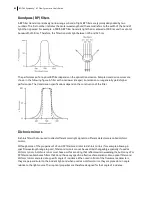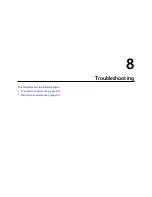
About optics
Introduction
This topic describes the optics system and provides information about:
l
l
l
Optical filter theory (page 80)
l
Optics system
The optics system consists of lasers, optical filters, and detectors. Lasers illuminate the cells or particles in the
sample and optical filters direct the resulting light scatter and fluorescence signals to the appropriate detectors.
Light scatter
When a cell or particle passes through a focused laser beam, laser light is scattered in all directions. Light that
scatters axial to the laser beam is called forward scatter (FSC) and light that scatters perpendicular to the laser
beam is called side scatter (SSC).
FSC and SSC are related to certain physical properties of cells.
l
FSC
Indicates relative differences in the size of the cells or particles. Larger cells scatter more light and
therefore they are higher in FSC.
l
SSC
Indicates relative differences in the internal complexity or granularity of the cells or particles. More
granular cells deflect more light than less granular cells, and therefore are higher in SSC.
Fluorescence
When cells or particles stained with fluorochrome-conjugated antibodies or other dyes pass through a laser
beam, the dyes can absorb photons (energy) and be promoted to an excited electronic state. In returning to
their ground state, the dyes release energy, most of which is emitted as light. This light emission is known as
fluorescence.
Fluorescence is always a longer wavelength (lower-energy photon) than the excitation wavelength. The
difference between the excitation wavelength and the emission wavelength is known as the Stokes shift. Some
fluorescent compounds such as PerCP exhibit a large Stokes shift, absorbing blue light (488 nm) and emitting
red light (675 nm), while other fluorochromes such as FITC have a smaller Stokes shift, absorbing blue light
(488 nm) and emitting green light (530 nm).
Actual emission intensity will depend on excitation wavelength. See
Fluorescence spectra (page 98)
for more
information on excitation and emission of fluorochromes. An interactive spectrum viewer is also available at
Chapter 7 Technical overview
79
Содержание FACSymphony A1 Flow
Страница 1: ...FACSymphony A1 Flow Cytometer User s Guide 23 23437 01 2022 07 For Research Use Only ...
Страница 6: ......
Страница 10: ...This page intentionally left blank ...
Страница 24: ...This page intentionally left blank ...
Страница 36: ...This page intentionally left blank ...
Страница 50: ...This page intentionally left blank ...
Страница 87: ...More information l Running a performance check page 55 Chapter 7 Technical overview 87 ...
Страница 88: ...This page intentionally left blank ...
Страница 96: ...This page intentionally left blank ...
Страница 120: ...This page intentionally left blank ...
















































